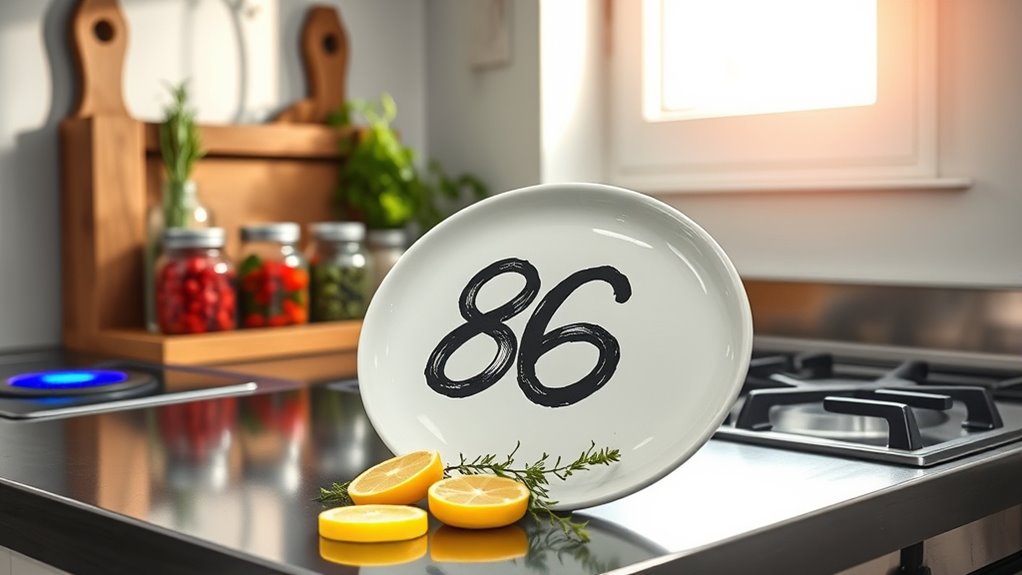In a kitchen, “86” is a code that lets you know an item is sold out, canceled, or no longer available. It helps staff communicate quickly during busy times to avoid preparing or serving unavailable dishes. When you hear “86,” it means you should stop what you’re doing with that item. Want to know the interesting origins and how it’s used across the industry? Keep exploring to learn more.
Key Takeaways
- “86” indicates an item is out of stock, unavailable, or needs to be removed from the menu.
- It serves as a quick communication code among restaurant staff to prevent unnecessary preparation.
- Originating possibly from 1930s New York restaurants, it became industry-wide for signaling unavailability.
- Using “86” helps maintain efficiency, reduce errors, and ensure smooth service during busy hours.
- It is part of the shared restaurant vocabulary, guiding staff to stop, remove, or note unavailable items.

If you’ve ever worked in a busy kitchen, you’ve probably heard the term “86” thrown around, but you might not know exactly what it means. In kitchen slang, “86” is a piece of restaurant terminology that signals something needs to be removed, stopped, or is no longer available. It’s a quick way for staff to communicate essential information without disrupting the flow of service. When a chef yells “86 the salmon,” it means the salmon dish is sold out or unavailable, and the kitchen staff should stop preparing it immediately. This shorthand keeps everyone on the same page amid the chaos, helping to prevent mistakes and maintain efficiency. Understanding the proper use of “86” can also improve overall restaurant communication and service quality.
Understanding the origin of “86” can be a bit tricky because there are several theories. Some suggest it comes from old bar or restaurant practices, where “86” was used as a code to indicate items were out of stock or a customer was being refused. Others believe it originated from 1930s New York, where a specific restaurant’s staff used “86” as a code to signal that an item was no longer available or a table was being cleared. Regardless of its true origin, it’s now firmly embedded in restaurant terminology and widely recognized across the industry.
As you become more familiar with kitchen slang, you’ll see that “86” isn’t just about items being out of stock. It can also indicate that a dish has been canceled, a customer has declined an upsell, or a station has run out of ingredients. For example, if a server says, “86 the Caesar salad,” they mean it’s no longer an option for the table. The term also helps prevent errors; when everyone knows an item is “86,” cooks won’t waste time preparing something that shouldn’t be served. It’s a simple, effective way to keep communication clear amid the noise and rush of a busy restaurant.
In addition to being a quick code, “86” has become part of the broader restaurant vocabulary. It’s used by front-of-house and back-of-house staff alike, creating a shared language that streamlines operations. Whether you’re a new server, an experienced line cook, or a manager, understanding “86” helps you stay in sync with your team. It’s a prime example of how restaurant terminology and kitchen slang serve a practical purpose: keeping service smooth, reducing mistakes, and ensuring everyone knows what’s happening at all times. So next time you hear “86,” you’ll know it’s a signal to stop, remove, or note that something’s no longer available.
Frequently Asked Questions
When Did the Term “86” Originate in Restaurant Slang?
You might wonder when “86” started in restaurant slang. Its history origin traces back to the early 20th century, with popular theories linking it to Prohibition or specific restaurant codes. Over time, the slang evolved, becoming a quick way to indicate an item’s removal from the menu or a customer’s request. Today, “86” is a common term, showcasing how slang evolves to streamline communication in busy kitchens.
Is “86” Used Universally Across All Kitchen Types?
You’ll find that “86” isn’t used universally in all kitchens, as kitchen jargon and menu abbreviations vary widely. Some establishments stick to local or specific industry slang, so “86” might be common in American restaurants but unfamiliar elsewhere. Always pay attention to local conventions, and don’t assume all kitchens use the same terminology. Knowing this helps you better communicate with staff and understand menu notes worldwide.
Are There Alternative Terms Similar to “86” in the Culinary Industry?
You might think “86” is the only way to say something’s out, but the culinary world has a treasure trove of alternative phrases and slang equivalents. Terms like “drop,” “kill,” or “take off” serve similar purposes, helping you quickly communicate that an item is gone or no longer available. These phrases add flavor to your kitchen lingo, making your communication as lively and vivid as a bustling restaurant.
How Is “86” Communicated During Busy Restaurant Hours?
During busy restaurant hours, you communicate “86” through clear kitchen communication, often using verbal cues or hand signals to make certain staff coordination. You might also use a designated phrase or code word, like “off the menu,” to quickly alert team members. Staying concise and consistent helps prevent confusion, ensuring everyone knows when an item is unavailable without disrupting the flow, especially during high-pressure periods.
Does “86” Have Different Meanings in Different Regions or Countries?
You’ll find that “86” does have different meanings across regions and countries, reflecting cultural differences. For example, in the US, it often means to remove an item, while in Australia, it can imply a customer’s request for a specific drink. Regional variations are common, and understanding them helps you communicate clearly. Recognizing these differences guarantees smoother teamwork and better service in diverse culinary environments worldwide.
Conclusion
So, now you know that “86” in a kitchen isn’t just a number—it’s the secret code to saving your sanity during the busiest hours! When things get chaotic and an ingredient or dish needs to vanish instantly, just shout “86,” and you’ll feel like a culinary superhero. It’s your ultimate weapon against kitchen chaos, turning chaos into calm in seconds. Trust me, once you master “86,” your kitchen will never be the same again!









